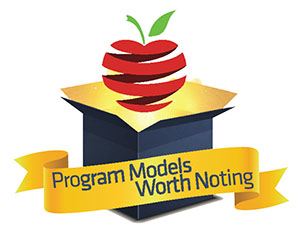
Career academies are a programmatic model that engages high school students to explore college and career opportunities. This model has a large geographical scope and allow donors to engage in coalition-building. In addition to supporting strong programs, high impact philanthropy can also include advocacy, awareness raising, and providing support to public systems.

What It Does
For a young person seeking sustainable employment, a high school degree is a critical benchmark. While high school dropout rates in the U.S. have decreased over the last de-cade, some 500,000 students still drop out per year. Engaging high school students with real-world experiences and opportunities can keep them on track for on-time graduation, as well as better prepare them for college and satisfying employment. Career academies operate as schools within high schools that allow students to take both career-related and academic courses, as well as acquiring work experience through partnerships with local employers. Career academies can be standalone schools, say, a performing arts school, or “small learning communities” of about 150 to 200 students within larger high schools. Students are grouped by their career theme (such as information technology, health science or business) often in clusters of 50 to 75 students who remain together with the same teachers and support staff, allowing them to receive more individualized attention. These positive relationships are important: Teacher trust increases student attendance and grade point averages.
How Effective Is It
A randomized control trial study of nine career academies in or near large U.S. urban districts found that participating students earned on average $216 more a month than non-participating students — that’s enough to push a family of four out of poverty. This difference persisted through the end of the study, eight years after the students graduated. Other studies have confirmed improved edu-cational outcomes associated with the model. For example, one study in California found that career academies’ participants were less than half as likely to drop out of high school compared with non-academy students.Launching new career academies cost about $800 per student per year, including start-up costs, though costs reduce to about $500 per student per year after the first few years. An independent cost-benefit analysis of California career academies found that they return at least $3 for every dollar invested.
How You Can Help
Donors can support a local career academy directly or fund an intermediary nonprofit that helps career academies improve regionally/nationally: The National Academy Foundation (NAF) is a direct service organization, implementing their own academies in partnership with communities. NAF currently runs 644 academies across 36 states, serving about 100,000 students. To find a local NAF academy, visit https://naf.org/naf-network/find-an-academy. The National Career Academy Coalition (NCAC) provides guidance to member schools on using evidence-based standards of practice, and maintains a list of “model” implementers here: https://www.ncacinc.com/basic-page/ncac-model-academies-2012-present. A gift of $250 pays for annual membership to NCAC so its teachers can learn from national best practices, while $4,000 covers four years of evaluation support necessary for school leaders to understand what’s going well and how they can improve. The College & Career Academy Support Network (CCASN), at the University of California-Berkeley, provides career academy teachers, schools, and districts with professional development, coaching, materials, and technical assistance but also conducts ongoing research and policy work to determine what makes them successful.In addition to philanthropic funding, donors can volunteer individually or help to create corporate partnerships through their workplaces so that the academies have a sustainable way to provide real-world work experiences to their students.
